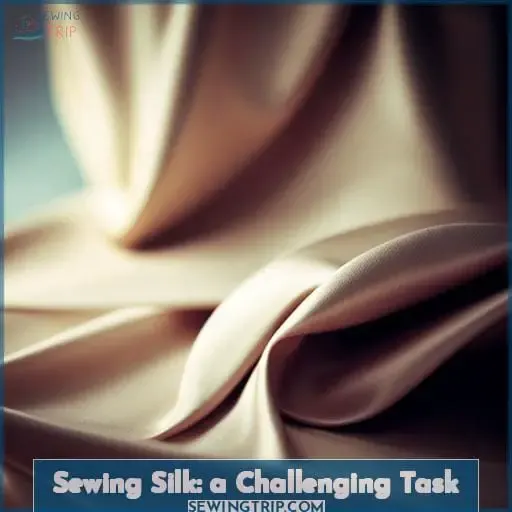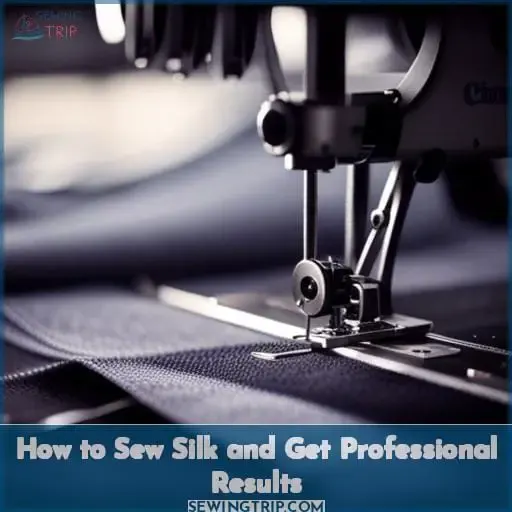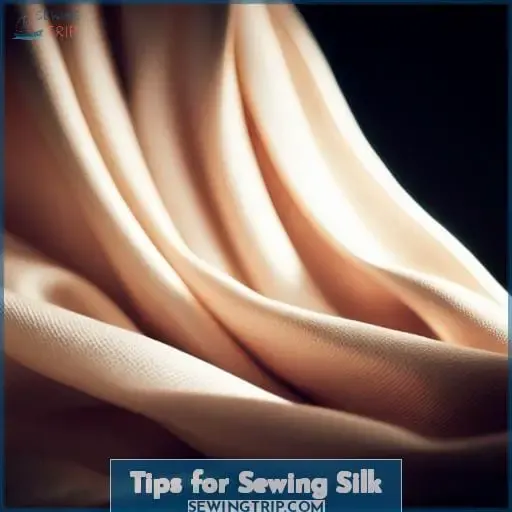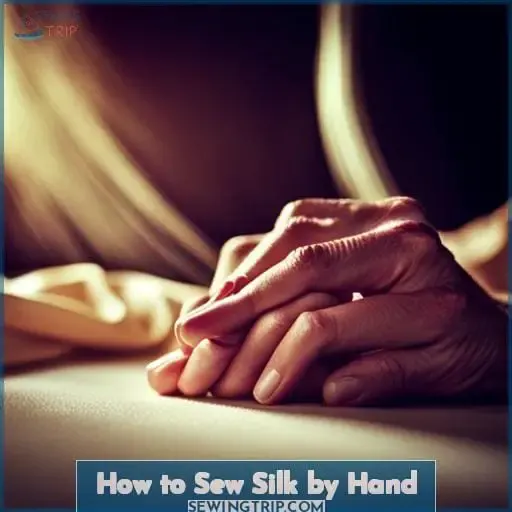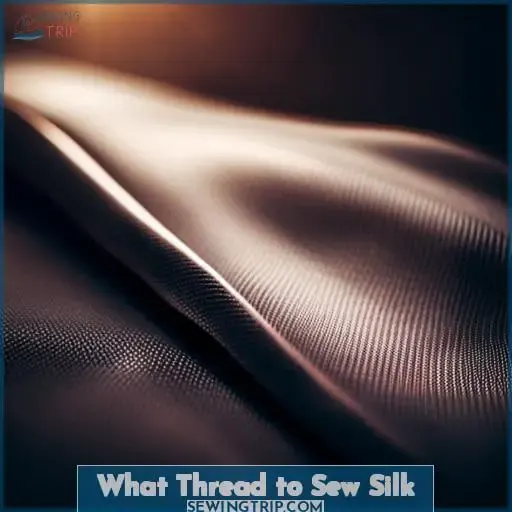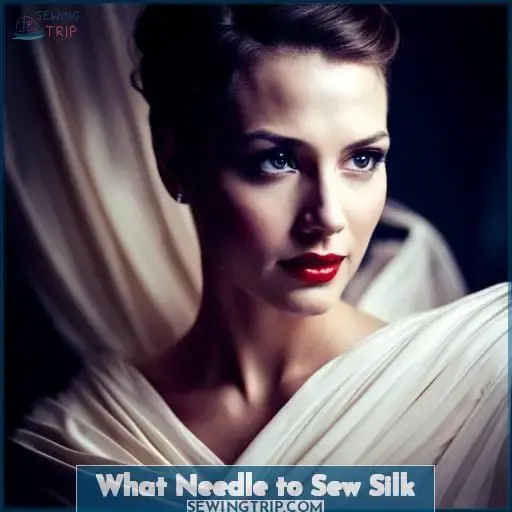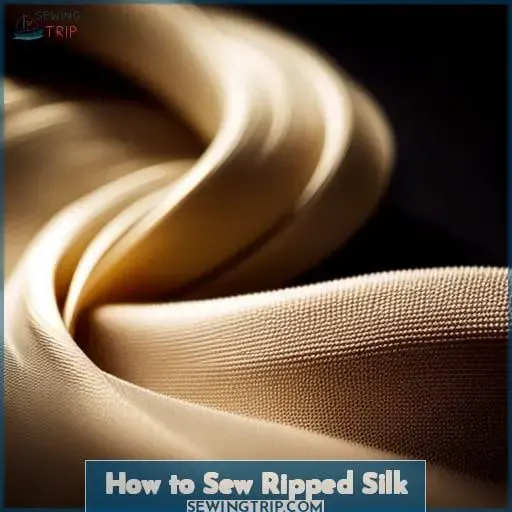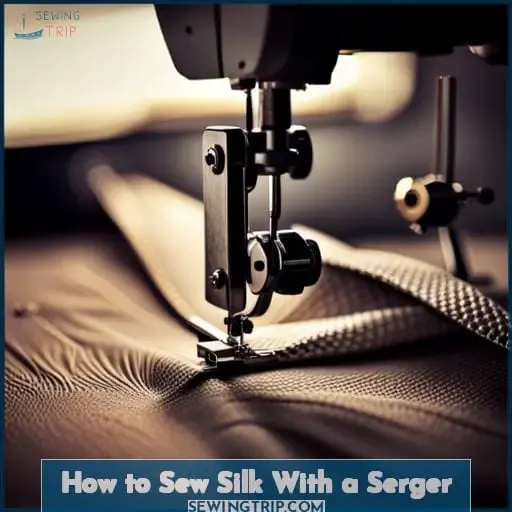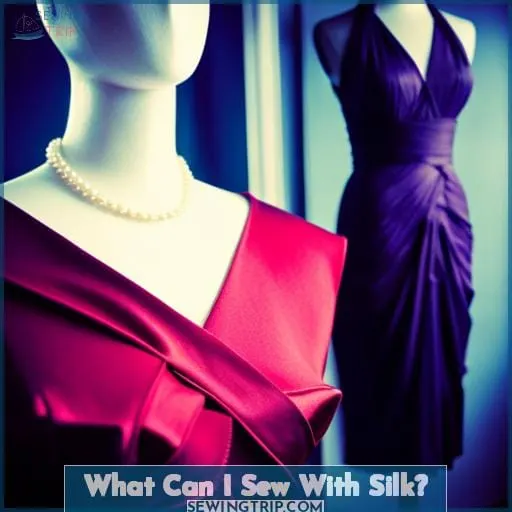This site is supported by our readers. We may earn a commission, at no cost to you, if you purchase through links.
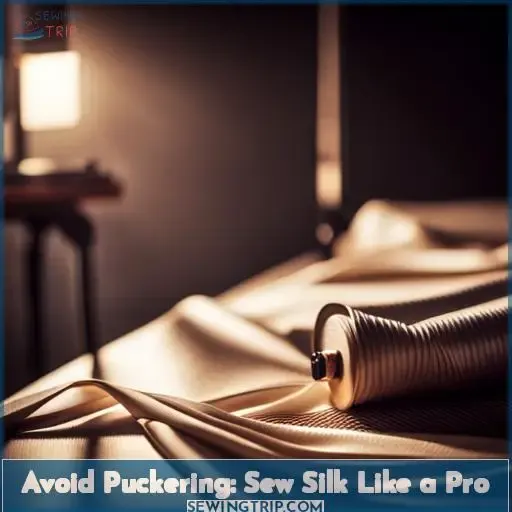 If you are a fashion designer, sewing instructor or tailor struggling with how to sew silk without puckering, this guide will help. Puckering is not caused by the silk itself – it happens due to lack of the right tools and experience.
If you are a fashion designer, sewing instructor or tailor struggling with how to sew silk without puckering, this guide will help. Puckering is not caused by the silk itself – it happens due to lack of the right tools and experience.
This article covers everything from stabilizing fabric with interfacing to the best needles for your machine and hand-sewing techniques.
First, always stabilize silk with a lightweight interfacing before cutting and sewing. This adds body and prevents stretching as you work. Use a fine needle size 10-12 in your sewing machine and do not over-manipulate or pull the silk as you sew.
For hand-sewing, use a silk thread in a matching color along with small stitches. Do not knot the thread but secure stitches by overstitching in place. Press seams flat as you go using a cool iron.
When finishing seams, consider French seams encasing the raw edges or use pinking shears. Avoid bulky seam finishes. Use fine silk or polyester thread in the needle and bobbin, rather than cotton. Work slowly and do not rush when sewing silk! With a gentle touch and the right tools, you’ll achieve beautiful results.
Table Of Contents
Key Takeaways
- Start by stabilizing silk with lightweight interfacing.
- Use fine needles (size 10-12) for the sewing machine.
- Avoid over-manipulating or pulling the silk while sewing.
- Secure stitches by overstitching instead of knotting.
Sewing Silk: a Challenging Task
Sewing silk is a challenging task. Cut and fuse a lightweight interfacing to the silk fabric for stability before sewing. Select needles with sharp points and small eyes, like sizes 60/8 to 70/10, to pierce the silk cleanly.
Use a fine 100% silk thread matching the fabric color. Check the sewing machine’s tension, a stitch length of 1.5-2mm, and the straight stitch plate. Gently lower the presser foot and sew slowly. For hand sewing, pick small needles and evenly spaced 1 1⁄2-2mm stitches. Keep the fabric flat and taut.
First, test samples and make any needed tension and stitch adjustments. With proper tools, settings, and gentle techniques, you can sew silk successfully without frustrating puckers.
How to Sew Silk and Get Professional Results
Sewing smooth seams with silk can be tricky, but with the right supplies and tactics, you’ll get professional results. Use a lightweight fusible interfacing to stabilize the fabric. Choose fine machine needles and thread to avoid snags.
Adjust your sewing machine settings for best stitching on slippery silk. Varying your stitch length can help. Take your time and go slowly on curves or corners. Use lots of pins to hold pieces together neatly while sewing.
Press seams flat as you go to prevent puckering. With care, your silk projects can have perfectly sewn seams and a high-end finished look.
Use Interfacing to Stabilize Silk Fabric
After expertly stabilizing, you’ll successfully sew silk sans puckering. Choose fusible interfacing to reinforce the delicate silk fabric. Apply the interfacing to the wrong side as directed on the package instructions.
Allow the fabric to cool down completely before moving it. The silk is now prepared for smooth sewing. Stay attentive when cutting, pinning, and stitching to maintain the structured feel. With care, your silk will turn out flawless. The stabilized fabric is ready for pristine sewing.
Best Needle for Silk Fabric
Look, using a size 8/60 Microtex sharp needle can sew silk without puckering. Choose a needle with an ultra-fine point and small eye specifically designed for silks. Size 8/60 needles glide smoothly between silk threads without snagging or breaking them.
Pick needles sized between 8/60 and 10/70 for most silk fabrics. Accompany your silk needle with a straight stitch presser foot that has a smooth underside to prevent catching. With the right needles and feet, your sewing machine will produce beautiful, pucker-free seams on delicate silks.
Best Thread for Sewing Silk Fabric
Lustrous silk threads bring your delicate projects to life. For gorgeous results, choose silk threads with a subtle sheen that glide smoothly through lightweight silk fabrics without fraying seams. Avoid coarser threads like polyester, lower the tension slightly, and reduce your stitch length.
Sewing Machine Settings for Silk
When mastering silk sewing, stabilize slippery fabric with interfacing and slow down your machine. Use silk thread in a 1.5mm stitch length with reduced foot pressure. Confidently choose the finest needles and thinnest threads for flawless stitching.
Experiment with stabilizers until you achieve smooth seams, then share your silk mastery. Sewists yearn for the soft glow of silk, so guide them gently. Together we’ll stitch heirloom garments with care, creating beauty that endures.
Tips for Sewing Silk
When sewing silk, consider these useful tips for avoiding puckered seams. Install a straight stitch needle plate and place tissue paper between the plate and fabric to prevent slipping. Silk can be slippery, so take care when sewing. Choose the right needle – a sharp needle will pierce the threads neatly.
Use quality thread that is fine enough for the fabric. Lengthen your stitch to allow the fabric to move without resistance. Avoid pulling or stretching the fabric as you sew. Press seams flat, using a pressing cloth to protect the silk.
Sew Silk With a Straight Stitch Plate
You’d wanna insert a straight stitch plate when sewing silk to keep it taut. Without stabilization, silk easily distorts. A straight stitch plate provides a smooth surface so your project glides evenly.
Carefully align the plate’s single hole with your machine’s needle. Select the right needle—sharp enough to pierce but not damage. Try a size 60/8 to start. Lower the presser foot gently. Reduce the pressure if needed.
Go slowly, easing the silk through. The straight stitch plate prevents sideways motion, keeping seams straight. For ultimate control, use the hand wheel. Let the plate work its magic—no more frustrating puckers on your silk sewing projects.
With practice, you’ll achieve that smooth professional finish. Your silk will sing as it flows under the needle, guided by the straight stitch plate’s firm but gentle hand.
Use Tissue Paper
Put a tissue between the needle plate and fabric to keep silk from sliding as you stitch. The tissue prevents puckering by stabilizing the slippery silk so it can’t shift around. Choose a lightweight tissue that won’t leave residue on your fabric. Tape it down or hold it taut as you sew.
Go slowly, since the tissue adds friction. Check your work to ensure the tissue hasn’t left marks. This simple trick lets you glide effortlessly through silk projects. With practice, you’ll become a master at sewing smooth seams in silk without frustration.
Soon tissue paper will be an indispensable tool in your sewing arsenal for perfectly puckered-free silk.
How to Sew Silk by Hand
Keep the smoothness using the finest needles and coolest irons! When hand sewing silk, choose the smallest sharp needle, like a size 60/8, for tiny and even stitches.
Hand baste first with long running stitches before final sewing. Keep your stitches around 1 1/2 to 2 mm in length to prevent distortion on the silk fabric. Don’t tie knots, but weave thread ends into the seam allowance instead. Use 100% silk thread that matches or contrasts nicely with your fabric.
For repairs, fuse a silk patch first before closing the hole with tiny stitches. Whether you’re sewing silk pajamas, pillowcases, or jersey, hand sewing maintains the delicate nature of silk. With care, your creation will have a smooth finish to showcase the elegance of silk.
How to Sew Silk on a Sewing Machine
Choose stabilizers and lubricants to float fabric gently through manufacturing. Proper tools and techniques are key to machine sew silk without puckering.
- Opt for a sharp microtex needle in a small 60/8 or 70/10 size. The eye should accommodate thread without shredding silk.
- Go for 100% silk threads that match fabric weight. Lightweight cotton or polyester works too.
- Fuse lightweight stabilizers to prevent stretching on the bias. Silk organza strips add structure at seams.
- Place tissue paper beneath when sewing to reduce friction. Adjust presser foot pressure as well.
- Set a shorter 1.5-2mm stitch length. Lengthen only in high stress areas. For control, sew slowly and guide silk manually when possible.
With the right needle, thread, interfacing, lubrication and stitch settings, machine sewing silk can result in smooth, professional results for pillowcases, pajamas or any delicate handling project.
What Thread to Sew Silk
You’ll cherish the sheen of 100% silk thread gliding smoothly through delicate silk fabric. For the ultimate luxury, pick a lustrous silk sewing thread like Splendor or Sylko. Match the thread weight to your fabric thickness. A fine weight, like 40wt silk, prevents puckering light fabrics.
Heavier 30wt silk stands up to slinkier textures. Adjust your machine tension so the bobbin slightly peeks through to the top. Install a new sharp needle – thick threads can fray on dull points. For added insurance, place tear-away stabilizer underneath.
Draw designs on top and sew through both layers. Remove backing gently after stitching. Your creative possibilities bloom with quality materials! Experiment with decorative techniques like smocking and applique.
What Needle to Sew Silk
Place a small, smooth needle between your fingers as you gently guide the sheer silk through the machine. When sewing lightweight silk fabrics, needle selection is crucial for preventing snags and pulls.
- Size – Select a fine, thin needle like a 60/8 or 70/10 to pierce silk fibers without damage.
- Point – A sharp point easily penetrates silk, while a round point risks fraying threads.
- Eye – A needle with a tiny eye accommodates fine silk threads without shredding.
Beyond size and shape, the needle material affects stitch quality. Nickel-plated needles smoothly pass through silk with reduced friction. Untreated steel needles can snag. With the proper needle, you can sew sheer silk as fluidly as a ribbon through the air.
Discover silk’s full potential by pairing it with a needle designed to protect its delicate essence.
How to Sew Ripped Silk
Fuse a lightweight interfacing to the underside before stitching closed the rip with small, even hand stitches using fine silk thread. Choose an inconspicuous thread color that matches the silk fabric closely. Test different shades against the silk in natural light to find the best color match.
For structural tears, cut a small patch of matching silk, fuse interfacing, and appliqué over the damaged area, neatly stitching around the edges. On garment seams or hems, consider hand stitching a new French seam or hem, reinforcing with silk organza strips if needed.
For fine tears, sometimes a row of tiny hand stitches right along the rip is enough to stabilize without a full patch.
With a bit of finesse, perseverance, and the right materials, repairs on delicate ripped silks can be made nearly invisible. The key is taking the time to match colors perfectly and make stitches diminutive yet sturdy.
How to Sew Silk With a Serger
Gently guide the silk through the serger as you experiment with pressure, tension, and needle size for beautiful seams.
- Adjust the presser foot pressure. Silk needs a lighter touch than most fabrics. Start with a lower foot pressure setting and increase slowly while testing on scraps.
- Check the thread tension. The balanced tension that works for other fabrics may be too tight for delicate silk.
- Choose the right needle. Use fine needles around sizes 10/70 to 14/90 for silk. Ballpoint needles help prevent skipped stitches.
When serging silk seams, go slow and steady. Make small test adjustments to find the sweet spot for stitch formation without damaging the fabric. A perfectly tuned serger helps silk fabric glide through for tidy professional inside seams.
What Can I Sew With Silk?
With passion and pride, craft your dreams into reality.
From party-turning dresses to silky pillows or even breezy lingerie, silk fabric unleashes endless creative possibilities.
Weave silk’s refined elegance into lavish garments like flowing evening gowns, sleek slacks, or fanciful blouses. Accent with accessories – imagine a silk scarf catching the breeze or a satin clutch bag completing your ensemble.
Adorn your home through the art of decor – luxurious silk bedding or elegant lampshades draped in shimmering splendor. Add a sensual touch with lacy silk lingerie or explore expansive styles from teddies to glamorous robes.
Wherever your vision leads, silk strands dance to bring it to life. Trust this noble cloth to elevate any endeavor into a masterpiece.
Conclusion
Sewing silk can be a daunting task, but with the right tools, techniques, and advice, you can achieve professional results without puckering. Leverage interfacing to stabilize silk fabric. Use the appropriate needle and thread.
Adjust your sewing machine settings for a smooth and even stitch. When hand sewing, take extra care by using a straight stitch plate, tissue paper, and pins or weights to secure the fabric. For ripped silk, use fusible fabric or patches and don’t forget to adjust the presser foot and needle tension when using a serger.

